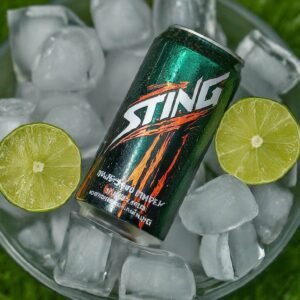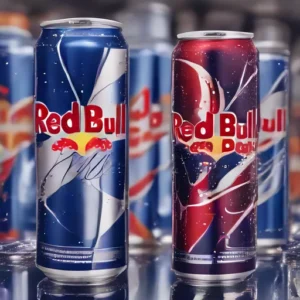Energy drinks have become a go-to solution for many people looking to boost their energy levels, especially during long work hours or intense physical activities. Among the myriad of options available, Red Bull and Sting stand out as two of the most popular choices.
In this article, we discuss the Red Bull vs String energy drinks and explore which one is best from them. Also explore the Red Bull vs Coffee drinks.
Nutrient Comparison Table
| Nutrient | Red Bull (8.4 fl oz) | Sting (8.4 fl oz) |
| Calories | 110 | 124 |
| Total Fat | 0g | 0g |
| Sodium | 105mg | 100mg |
| Total Carbohydrates | 28g | 30g |
| Sugars | 27g | 28g |
| Protein | 1g | 0g |
| Caffeine | 80mg | 71mg |
| Niacin (Vitamin B3) | 22mg (110% DV) | 2mg (10% DV) |
| Vitamin B6 | 5mg (250% DV) | 0.5mg (25% DV) |
| Vitamin B12 | 5.1µg (85% DV) | 0.5µg (8% DV) |
| Pantothenic Acid | 5mg (50% DV) | Not listed |
Red Bull vs String: Similarities and Differences

When comparing Red Bull and Sting, two popular energy drinks, it’s essential to understand their similarities and differences to make an informed choice.
I’ll break down the comparison in simple terms, focusing on factual information and key figures. Also explore the Red Bull Vs Monster Energy drinks.
Similarities
- Purpose: Both Red Bull and Sting are designed to boost energy and improve alertness. They are marketed as energy drinks that help to increase physical and mental performance.
- Caffeine Content: Caffeine is a primary ingredient in both drinks, acting as a stimulant. Red Bull contains approximately 80 mg of caffeine per 250 ml can, while Sting has around 50 mg of caffeine per 250 ml can. Both amounts are designed to provide an energy boost, though Red Bull’s content is higher.
- Sugar Content: Both drinks contain high levels of sugar. A 250 ml can of Red Bull has around 27 grams of sugar, while the same amount of Sting contains about 27 grams as well. This high sugar content contributes to the immediate energy boost both drinks provide.
- Vitamins: Both energy drinks include B vitamins, such as B3 (niacin), B5 (pantothenic acid), B6, and B12. These vitamins help in energy metabolism, making them a common addition to energy drinks.
Also explore that how much Caffeine does a Red Bull have
Differences
- Brand Origin and Market: Red Bull originated in Austria and is a globally recognized brand with a significant market presence worldwide. Sting, on the other hand, is produced by PepsiCo and is more prevalent in markets like Southeast Asia.
- Ingredients: While both drinks contain caffeine and sugar, Red Bull includes taurine, an amino acid believed to enhance athletic performance and improve mental focus. Sting does not contain taurine but includes ginseng extract, known for its potential to boost energy levels and reduce fatigue.
- Flavor Variants: Red Bull offers a variety of flavors beyond its original formula, such as Red Bull Sugarfree, Red Bull Zero, and seasonal editions with different flavors. Sting, however, is usually available in fewer flavors, typically focusing on its original and berry variants.
- Nutritional Profile: Beyond sugar and caffeine, the nutritional content varies slightly. For instance, Red Bull has about 110 calories per 250 ml can, while Sting has approximately 120 calories for the same amount. This slight difference is due to varying ingredient compositions and additional extracts in each drink.
- Price Point: Generally, Red Bull is priced higher than Sting. This price difference reflects Red Bull’s premium market positioning and extensive global marketing campaigns. Sting, being a more regionally focused brand, tends to be more affordable.
Red Bull vs String: Effects on Health

When comparing Red Bull and Sting, two popular energy drinks, it’s essential to understand their effects on health. Both drinks are marketed for their ability to boost energy and alertness, but their ingredients and impacts can differ significantly.
Red Bull: What’s Inside and Its Effects
Red Bull is one of the most well-known energy drinks globally. Here’s a breakdown of its primary components and their effects on health. Also explore the side effects of Red Bull.
- Caffeine: A standard 8.4 fl. oz (250 ml) can of Red Bull contains 80 mg of caffeine. Caffeine is a stimulant that can improve alertness, concentration, and physical performance. However, excessive intake can lead to restlessness, insomnia, and increased heart rate.
- Sugars: Red Bull contains about 27 grams of sugar per can. While sugar provides a quick energy boost, it can also lead to a rapid spike in blood sugar levels followed by a crash. High sugar intake is linked to obesity, type 2 diabetes, and dental problems.
- Taurine: Each can has 1000 mg of taurine, an amino acid that supports neurological development and regulates water and mineral levels in the blood. Taurine is generally considered safe in moderate amounts, but its long-term effects are not well-studied.
- B-Vitamins: Red Bull includes B vitamins like B6, B12, niacin (B3), and pantothenic acid (B5), which help convert food into energy. While beneficial, these vitamins are usually available in sufficient amounts through a balanced diet.
Sting: Ingredients and Health Impact
Sting is another energy drink that’s particularly popular in Asia. Here’s what’s inside:
- Caffeine: A 250 ml can of String contains approximately 50 mg of caffeine, slightly less than Red Bull. The effects are similar, providing a temporary boost in alertness and energy, but with potential side effects if consumed in excess.
- Sugars: Sting also contains about 27 grams of sugar per can, leading to the same health concerns related to high sugar consumption.
- Taurine: Sting includes 400 mg of taurine per can, less than Red Bull. The effects of taurine remain consistent, offering potential benefits in moderation.
- B-Vitamins: Like Red Bull, Sting is fortified with B vitamins, supporting energy metabolism but not providing significant benefits beyond a healthy diet.
Also explore that Does Red Bull Expire?
Comparing Health Effects
When comparing Red Bull and Sting, several health considerations come into play:
- Caffeine Content: Red Bull has more caffeine per can, which might offer a stronger boost but also carries a higher risk of side effects like jitteriness and increased heart rate, especially for those sensitive to caffeine.
- Sugar Content: Both drinks have high sugar content, contributing to potential health risks such as weight gain, insulin resistance, and dental problems. The American Heart Association recommends a daily sugar intake limit of 36 grams for men and 25 grams for women, meaning one can of either drink nearly reaches or exceeds this limit.
- Taurine and B-Vitamins: While both drinks contain taurine and B vitamins, the levels are not vastly different, and their moderate consumption is generally considered safe.
Expert Recommendations
- Moderation: Consuming these energy drinks in moderation is key. It’s essential to be aware of the total caffeine and sugar intake from all dietary sources to avoid adverse health effects.
- Healthier Alternatives: Consider other methods to boost energy, such as regular physical activity, adequate sleep, and a balanced diet rich in fruits, vegetables, and whole grains.
- Read Labels: Always check the nutrition labels of energy drinks and be mindful of the ingredients and their quantities.
Conclusion
Choosing between Red Bull and Sting depends on your personal preferences and needs. If you are looking for a stronger, longer-lasting energy boost and don’t mind paying a bit more, Red Bull is the better choice.
On the other hand, if you prefer a sweeter taste and a more budget-friendly option, Sting might be the way to go. Both drinks have their own unique set of benefits and drawbacks, so it’s important to consider what you value most in an energy drink.

